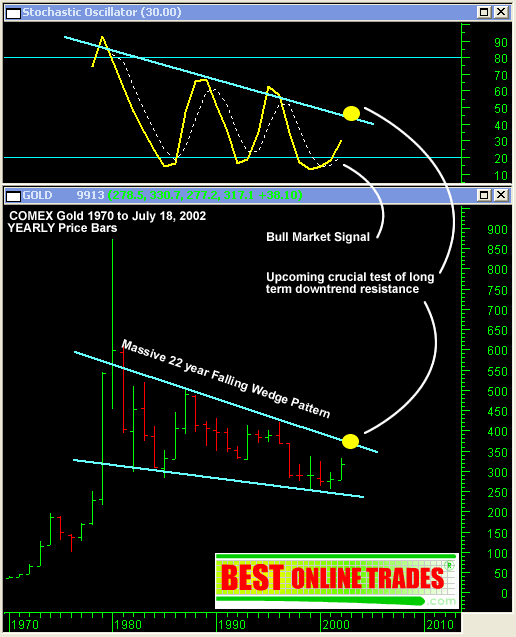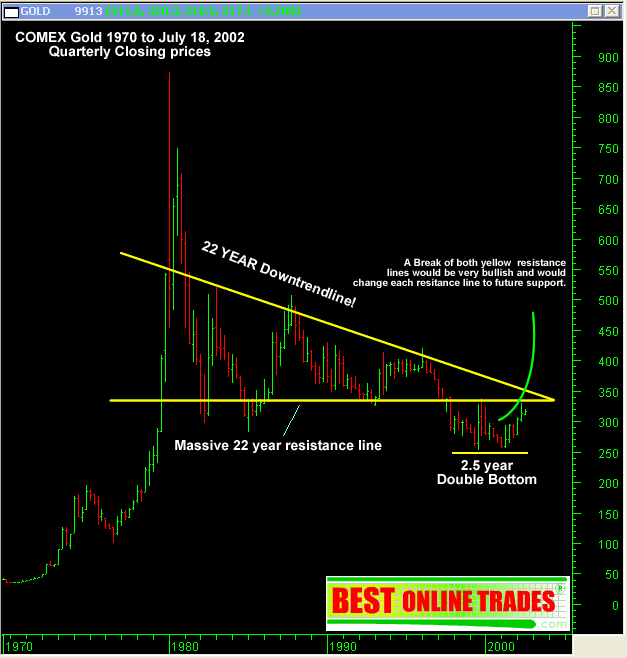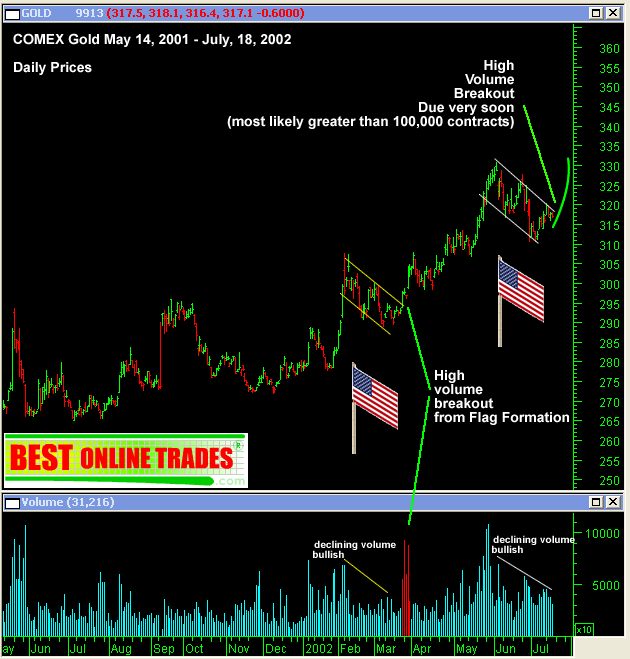The
Long Term Outlook for Gold - Yearly Time Frame...
Technical Analysis (TA)
is the study of price trends and volume over various time frames. I strongly believe
that in order to make high confidence investment decisions it is vital for you
to first consider long term TA charts. No matter what investment instrument you
are looking at, always look at the longest time frame chart FIRST in order to
gain proper perspective. So, assuming there is enough data in the series, start
with yearly price plots, then quarterly, monthly, weekly, daily and finally intraday.
Having said that, take a look at Chart 1 below. It is the yearly price of gold
chart (each price bar represents one year) going back to 1970 to present day July
18, 2002.
In my entire 7 years looking
at stock price charts I would have to say that Chart 1 below is surely one for
the history books. Why? There are a number of reasons. First, note that Chart
1 is plotted on a YEARLY scale. You must wait an entire year just to plot another
price bar on the chart! This implies that the oscillator plotted in the upper
half of chart one is also only affected just once per year. Clearly this chart
has some long-term implications. If you are somewhat familiar with Technical Analysis,
then you know that when an oscillator breaks out up above the 20th percentile
line, it issues a buy signal. The stochastic oscillator is good for identifying
shorter-term buy and sell points along a major trend. However, in the much longer
yearly time frame below, it is indicating a new bull market! Also
to note in Chart 1 is the very large ‘falling wedge’ price pattern.
This falling wedge is over 22 years long. It is a curious and yet fascinating
point that price chart patterns appear in all time frames, from 5 minute bar charts
to 22 YEARS. This is a bullish price chart pattern and implies prices will eventually
break out above the long 22 year overhead resistance line. Note the two yellow
circles on the chart, one directly at resistance on the price portion of the chart,
and the other directly at resistance on the oscillator portion of the chart. In
order to speak with utmost confidence that gold is in a new bull market, prices
will need to make a yearly close above that yellow circle. This will bring the
oscillator above its yellow circle as well, confirming the move.

Chart
1 |
Quarterly Time Frame
-
Often at the end of a falling wedge price pattern formation you
will see some form of a double bottom form. It is not clearly visible in the yearly
chart, but is evident in the quarterly gold price chart below (Chart 2). Notice
that this is a 2.5 year double bottom, giving it greater significance. You can
also see the downtrend line, which in Chart 1 made up the top portion of the falling
wedge price pattern. Aside from this downtrend line
resistance there is also the 330 level of resistance, which is the level that
we most recently have pulled back from and tested which was to be expected. This
330 level long-term resistance was also tested without success in the 1999 - 2000
time frame. This makes sense given the excessive supply that has been sitting
at this level for many years now. Assuming the 330 level will be successfully
broken through, the next most significant resistance will be in the 360 to 380
area. Price behavior at these levels will be giving very important indications
about the future price of gold since a sustained move above this level would indicate
that the long term 22 year resistance has been broken (i.e. New bull market territory)
The last important thing to note about Chart 2 is
that the period 1998 - 2002 has been an area of the chart where the price of gold is 'building cause' to attack and move above the long term resistance line. It
is not visible in Chart 2, but in the most recent 6 months a tremendous amount
of volume has been building under this resistance area. This is paramount in order
for Gold to get the 'escape velocity' necessary to break the long-term 330 resistance
level. The best analogy I can think of is a pressure cooker. The volume is the
steam and it is rising in temperature eventually causing the cover (330 resistance
line) to blow off.
Once Gold Bulls are able
to take prices above 330, they will feel vindicated and are likely to move the
price of gold much higher in a shorter time frame, possibly even creating a gap
up in prices. After looking at hundreds of charts over the years I have seen these
types of prices moves time and time again. For example during the blow off stage
of 1999 in the Nasdaq, there were many low priced small stocks that had been sitting
under resistance lines for many years. Once they were able to break these resistance
lines, prices moved sharply higher with little pause.

Chart
2 |
The Short Term Outlook
-
Now that you have the longer term perspective, lets zoom in and
see what is happening in the past year in Gold (Chart 3 May 14, 2001 to July 18,
2002). As you might expect, the price action is looking very bullish indeed. Consistent
up trends followed by orderly pullbacks resting on support. If you were to look
back at the beginning price action in the Dow or Nasdaq in 1982, the year the
bull market started, you will see similar price action.
Note
that if you closely examine the volume portion of Chart 3 you will see throughout
the past year lower volume on pullbacks and higher volume on breakouts. There
are symmetrical triangles, rectangles and as I have pointed out in Chart 3 below
bullish FLAG patterns. These are the patterns that bull markets are made of!
Focus
in on the two flag patterns in Chart 3. Flag and pennant chart patterns are known
to be quite reliable. They are continuation patterns, a pause and consolidation
after a sharp up move. As you can see the first flag was built starting in February
2002. The declining volume trend during the formation of this flag is bullish.
It indicates a drying up of sellers. Then, more importantly notice the volume
which I

Chart
3 |
colored in red. This
is the breakout volume, almost reaching 100,000 contracts, on two occasions of
the first flag formation; again a bullish situation. Now
fast forward to the most recent June July time period 2002. It appears we have
another flag formation that has finished as of this writing. Similarly, the volume
trend was on the decline during the formation of this second flag. It is interesting
to note also that the average total level of volume in the June July 2002 period,
is much greater than the February March 2002 consolidation period volume.
The
last 5 days of prices are doing what I call 'filling the pocket' right near the
top right hand corner of the flag. This is where the final sellers are washed
out and prices hover in a small crowded area before bursting higher.
A
break out to the upside from the second flag appears imminent as of this writing.
And this breakout will most likely be accompanied by a few days of greater than
100,000 contract volume. This is key to watch for in the coming days as it will
not only confirm the breakout of the second flag is real, but also provide enough
'fuel' to power above the long term resistance line of 330. Many
individual gold mining stocks have been in consolidation moves the past 2 months
forming symmetrical triangles and other forms of price consolidation on sharply
lower volumes. They are confirming the bullish flag formations in the price of
Gold.
THE BOTTOM LINE - In all three time frames
shown above (Charts 1 thru 3) there is growing bullish momentum for the Price
of Gold.
July 18, 2002
Thomas
Carreno
BestOnlineTrades.com
Back
to TOP
|